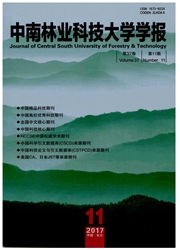

 中文摘要:
中文摘要:
2009年7月至8月,在湖南省植物园用树脂芯原位测定法,比较了樟树和马尾松群落土壤中无机氮含量及氮矿化速率。结果表明:培养前2种群落土壤中无机氮差异显著(P〈0.05),呈现马尾松〉樟树的规律,其中NH4+-N分别占群落土壤无机氮的98.2%和93.69%,是无机氮的主要存在形式;经过14、28和42 d的培养,樟树和马尾松群落土壤中NH4+-N和NO3--N含量均发生显著的变化(P〈0.01),NH4+-N的含量均呈现出先下降后上升的规律,NO3--N含量则表现出不同的规律,樟树群落为上升,马尾松群落为先下降后上升;樟树群落净氮矿化量为-(33.82±3.48)、-(16.81±5.90)和(29.14±4.41)mg.kg-1,马尾松群落为-(59.93±3.48)、-33.17和-13.11 mg.kg-1。
 英文摘要:
英文摘要:
Nitrogen mineralization was measured by using the resin-core technique from July to August,2009.It compared soil inorganic nitrogen contents and nitrogen mineralization rates was compared between Cinnamomum camphora and Pinus massoniana communities in the Botanical Gardens in Hunan Province.Results show that there was more soil inorganic nitrogen in Pinus massoniana than Cinnamomum camphora communities before incubation,and the difference was significant(P0.05).The ammonia nitrogen was the major form of inorganic nitrogen,which accounted for 98.2% and 93.69% of soil inorganic nitrogen of Cinnamomum camphora and Pinus massoniana communities;After 14 days,28 days and 42 days incubation,significant difference was found between soil ammonia nitrogen and nitrate nitrogen content of Cinnamomum camphora and Pinus massoniana communities(P0.01);The soil ammonia nitrogen content firstly showed a decrease and then an increase in both of Cinnamomum camphora and Pinus massoniana communities.The nitrate nitrogen content of C.camphora kept risiing trend and that of P.massoniana firstly decreased then increased;The net nitrogen mineralization contents of C.camphora communities were-(33.82±3.48)-(16.81±5.90) and(29.14±4.41)mg·kg-1,and that of P.massoniana communities were-(59.93±3.48),-33.17 and-13.11 mg·kg-1.
 同期刊论文项目
同期刊论文项目
 同项目期刊论文
同项目期刊论文
 期刊信息
期刊信息
